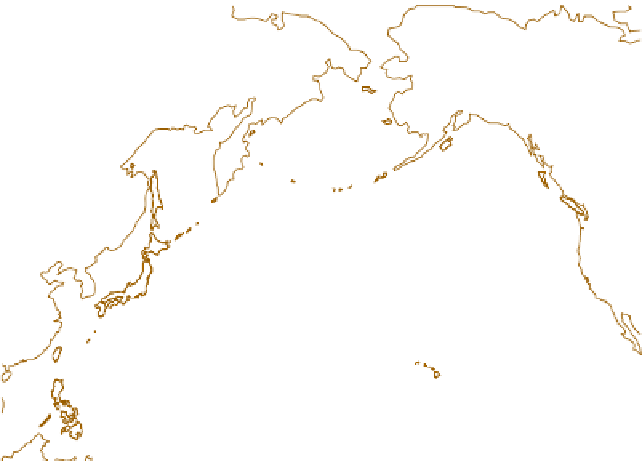Geoscience Reference
In-Depth Information
The Impact of Growing
Human Population on
the Natural Environment
The impact of this rapidly growing human population on the
Earth's environment is important in many ways. At the most
fundamental level a growing population means that more food is
required. The need for more food, in turn, means that more for-
ests are cleared to increase the amount of farmland. As discussed
in Chapter 11, soils will also be more heavily utilized and thus
degraded as farmers attempt to sustain or improve crop yields. A
growing population also means that more environmental pollu-
tion occurs, often in ways that the average person cannot imagine.
An excellent example of a growing but little known en-
vironmental impact is the huge expanse of trash in the north-
ern Pacific Ocean where the North Pacific gyre circulates
(Figure 20.3a). Many of the coastal countries along the Pacific
Rim, such as Japan, the Philippines, and the United States, are
The impact of early industrialization on human population
was dramatic. By 1800 the global population had reached about
1 billion. Much of this increase was driven by further techno-
logical developments, many of which were associated with san-
itation, as well as improvements in medicine that dramatically
enhanced human health. In response to these advances, average
life expectancy in the United States approached 50 by 1900. By
2000 the human population on Earth reached over 6 billion and
average life expectancy for those born in the United States was
over 77 years. As of July 2013, the global population was about
7.1 billion. According to the United Nations, population is pro-
jected at 8 billion by 2028 and 9 billion by 2050. In other words,
by the time a current college senior is about 60 years old, 2 bil-
lion more people will probably inhabit Earth than do now.
0
1000 km
0
1000 mi
N
t
A
Hawaii
quatorial C
urren
r Current
a
l
Figure 20.3 (a) The North Pacific gyre.
Note the counter-
clockwise circulation in the northern Pacific Ocean. This current
moves trash in a circular motion around the Pacific Ocean.
Figure 20.3 (c) Dead albatross on Midway Atoll, Hawaii.
This
bird died because it consumed plastic from the Pacific garbage
patch. Numerous albatross chicks have died in this manner be-
cause plastic was brought back to them to eat by their parents.
Figure 20.3 (b) Coastal trash on the Pacific Rim.
This gar-
bage circulated in the North Pacific gyre for an unknown period
of time before it washed ashore on this beach.




























































